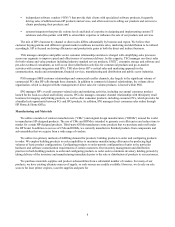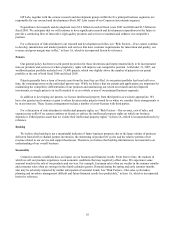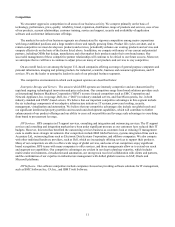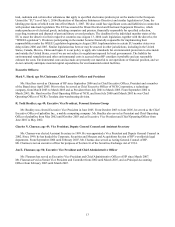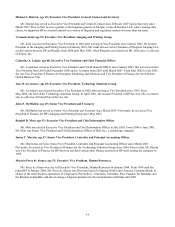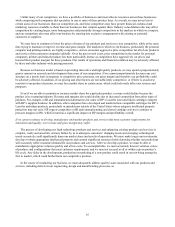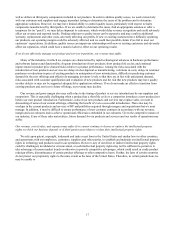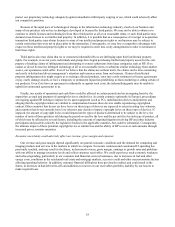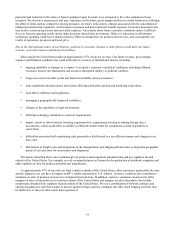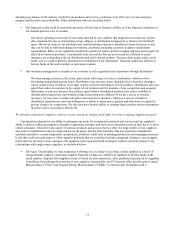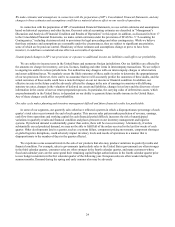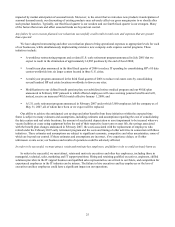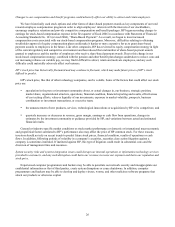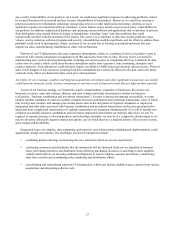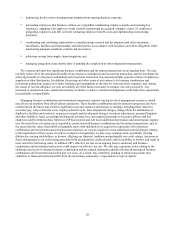HP 2007 Annual Report Download - page 32
Download and view the complete annual report
Please find page 32 of the 2007 HP annual report below. You can navigate through the pages in the report by either clicking on the pages listed below, or by using the keyword search tool below to find specific information within the annual report.protect our proprietary technology adequately against unauthorized third-party copying or use, which could adversely affect
our competitive position.
Because of the rapid pace of technological change in the information technology industry, much of our business and
many of our products rely on key technologies developed or licensed by third parties. We may not be able to obtain or to
continue to obtain licenses and technologies from these third parties at all or on reasonable terms, or such third parties may
demand cross-licenses to our intellectual property. In addition, it is possible that as a consequence of a merger or acquisition
transaction third parties may obtain licenses to some of our intellectual property rights or our business may be subject to
certain restrictions that were not in place prior to the transaction. Consequently, we may lose a competitive advantage with
respect to these intellectual property rights or we may be required to enter into costly arrangements in order to terminate or
limit these rights.
Third parties also may claim that we or customers indemnified by us are infringing upon their intellectual property
rights. For example, in recent years, individuals and groups have begun purchasing intellectual property assets for the sole
purpose of making claims of infringement and attempting to extract settlements from large companies such as HP. If we
cannot or do not license the infringed technology at all or on reasonable terms or substitute similar technology from another
source, our operations could suffer. Even if we believe that the claims are without merit, the claims can be time-consuming
and costly to defend and divert management’ s attention and resources away from our business. Claims of intellectual
property infringement also might require us to redesign affected products, enter into costly settlement or license agreements
or pay costly damage awards, or face a temporary or permanent injunction prohibiting us from marketing or selling certain of
our products. Even if we have an agreement to indemnify us against such costs, the indemnifying party may be unable to
uphold its contractual agreements to us.
Finally, our results of operations and cash flows could be affected in certain periods and on an ongoing basis by the
imposition, accrual and payment of copyright levies or similar fees. In certain countries (primarily in Europe), proceedings
are ongoing against HP seeking to impose levies upon equipment (such as PCs, multifunction devices and printers) and
alleging that the copyright owners are entitled to compensation because these devices enable reproducing copyrighted
content. Other countries that do not yet have levies on these types of devices are expected to extend existing levy schemes,
and countries that do not currently have levy schemes may decide to impose copyright levies on these types of devices. If
imposed, the amount of copyright levies would depend on the types of products determined to be subject to the levy, the
number of units of those products sold during the period covered by the levy and the per unit fee for each type of product, all
of which may be affected by several factors, including the outcome of ongoing litigation involving HP and other industry
participants and possible action by the legislative bodies in the applicable countries, but could be substantial. Consequently,
the ultimate impact of these potential copyright levies or similar fees and the ability of HP to recover such amounts through
increased prices, remains uncertain.
Economic uncertainty could adversely affect our revenue, gross margin and expenses.
Our revenue and gross margin depend significantly on general economic conditions and the demand for computing and
imaging products and services in the markets in which we compete. Economic weakness and constrained IT spending has
previously resulted, and may result in the future, in decreased revenue, gross margin, earnings or growth rates and problems
with our ability to manage inventory levels and collect customer receivables. We could experience such economic weakness
and reduced spending, particularly in our consumer and financial services businesses, due to increases in fuel and other
energy costs, conditions in the residential real estate and mortgage markets, access to credit and other macroeconomic factors
affecting spending behavior. In addition, customer financial difficulties have previously resulted, and could result in the
future, in increases in bad debt write-offs and additions to reserves in our receivables portfolio, inability by our lessees to
make required lease
18


